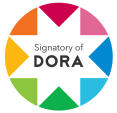Chrome Adsorption Through the use of Mining-Metallurgical Waste as Low-Cost Adsorbents
DOI:
https://doi.org/10.36790/epistemus.v15i31.195Keywords:
adsorption, waste, chromiumAbstract
In recent years, the waste generated by the metallurgical industries has received greater attention due to the environmental implications of its disposal, however, it has been reported that this type of waste works as low-cost adsorbents to remove heavy metals from wastewater. due to its composition. On the other hand, there are processes that are carried out in the metal coating industries that generate wastewater with a high content of hexavalent chromium, which is highly toxic to health and the environment. In the present work, a series of adsorption tests were carried out in a synthetic hexavalent chromium solution using as adsorbents residues from the mining-metallurgical industry. It was observed that, using a residue consisting mainly of hematite and magnetite, it was possible to remove 76% of the chromium present in the solution.
Downloads
References
E. Matinde, G. Simate and S. Ndlovu. “Mining and metallurgical wastes: a review of recycling and re-use practices”. The Journal of the Southern African Institute of Mining and Metallurgy, vol.118, pp. 825-844, 2018 DOI: https://doi.org/10.17159/2411-9717/2018/v118n8a5
Programa nacional para la prevención y gestión integral de los residuos 2017-2018.
U. Tezcan, S. Eroglu and E. Ozel. The treatment of chromium containing wastewater using electrocoagulation and the production of ceramic pigments from the resulting sludge. Journal of Environmental Management, vol. 200, pp. 196-203, 2017. DOI: https://doi.org/10.1016/j.jenvman.2017.05.075
M. Ataabadi, M. Hoodaji, A. Tahmourespour, M. Kalbasi and M. Abdouss. Optimization of factors affecting hexavalent chromium removal from simulated electroplating wastewater by synthesized magnetite nanoparticles. Environ Monit Assess, vol. 187, pp. 1-11, 2014. DOI: https://doi.org/10.1007/s10661-014-4165-z
Y. Bao, J. Huang, G. Cagnetta, and G. Yu. Removal of Fe-53B as PFOS alternative in chrome plating wastewater by UV/Sulfite reduction. Water Research, vol. 163, pp. 1-9, 2019. DOI: https://doi.org/10.1016/j.watres.2019.114907
H. Peng, Y. Leng, Q. Cheng, Q. Shang, J. Shu and J. Guo. Efficient Removal of Hexavalent Chromium from Wastewater with Electro-Reduction. Processes, vol. 7, pp. 1-12, 2019. DOI: https://doi.org/10.3390/pr7010041
M. Jadidi, M. Etesami and M. Esfahany. Adsorption and Desorption Processes of Chromium Ions Using Magnetic Iron Oxide Nanoparticles and Their Relevant Mechanism. Iranian Journal of Chemical Engineering, vol. 14, pp. 31-40, 2017.
E. Smith and K. Ghiassi, K. Chromate Removal by an Iron Sorbent: Mechanism and Modeling. Water Environment Research, vol. 78, pp. 84-93, 2006. DOI: https://doi.org/10.2175/106143005X84558
T. Petrova, L. Fachikov and J. Hristov. The Magnetite as Adsorbent for Some Hazardous Species from Aqueous Solutions: A Review. International Review of Chemical Engineering, vol. 3, pp. 134-152, 2011.
A. Gallo, M. Morales and E. Mazarío. Efect of the Surface Charge on the Adsorption Capacity of Chromium(VI) of Iron Oxide Magnetic Nanoparticles Prepared by Microwave-Assisted Synthesis. Water, vol. 11, pp. 1-12, 2019. DOI: https://doi.org/10.3390/w11112372
Downloads
Published
How to Cite
Issue
Section
License
Copyright (c) 2022 EPISTEMUS

This work is licensed under a Creative Commons Attribution-NonCommercial-NoDerivatives 4.0 International License.
The magazine acquires the patrimonial rights of the articles only for diffusion without any purpose of profit, without diminishing the own rights of authorship.
The authors are the legitimate owners of the intellectual property rights of their respective articles, and in such quality, by sending their texts they express their desire to collaborate with the Epistemus Magazine, published biannually by the University of Sonora.
Therefore, freely, voluntarily and free of charge, once accepted the article for publication, they give their rights to the University of Sonora for the University of Sonora to edit, publish, distribute and make available through intranets, Internet or CD said work, without any limitation of form or time, as long as it is non-profit and with the express obligation to respect and mention the credit that corresponds to the authors in any use that is made of it.
It is understood that this authorization is not an assignment or transmission of any of your economic rights in favor of the said institution. The University of Sonora guarantees the right to reproduce the contribution by any means in which you are the author, subject to the credit being granted corresponding to the original publication of the contribution in Epistemus.
Unless otherwise indicated, all the contents of the electronic edition are distributed under a license for use and Creative Commons — Attribution-NonCommercial-ShareAlike 4.0 International — (CC BY-NC-SA 4.0) You can consult here the informative version and the legal text of the license. This circumstance must be expressly stated in this way when necessary.
The names and email addresses entered in this journal will be used exclusively for the purposes established in it and will not be provided to third parties or for their use for other purposes.
























